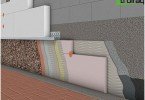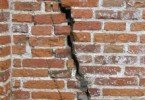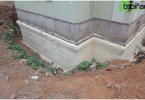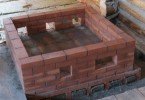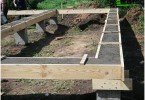The most effective base insulation
As the saying goes: “The master is the master.” That is why everyone decides for himself how to build, when, from what. But if you can deal with such questions on your own, then in order to answer, for example, the questions: “Do I need to make insulation of walls and foundations, and if necessary foundation insulation outside, is it worth doing the same inside? ” – the opinion of a specialist will be required, because only a trained eye of a pro can determine the degree of “need” in a particular case. And let’s find out how to better insulate the foundation – outside or inside?
Content
- The opinion of experts on the options for thermal insulation of the foundation
- How and how to insulate the foundation from the inside
- Materials and methods of insulation of the foundation outside
- Operational method – polystyrene insulation
- Providing thermal insulation with expanded clay
The opinion of experts on the options for thermal insulation of the foundation
For the most part, builders agree that it is best to insulate the foundation from the outside. In order not to be unsubstantiated, they cite sufficiently strong arguments in favor of this method.
- Regardless of the type of insulation used and the type of foundation, external thermal insulation allows you to protect the foundation from freezing, preventing the penetration of low temperatures into the structure.
- External insulation has a positive effect on the quality of concrete and on the construction of the foundation because, while maintaining their strength for many years.
- Also, external insulation is an additional barrier to groundwater, helping waterproofing protect the foundation from moisture.
- In addition to the lower part of the foundation, the external insulation resists the temperature differences that occur in the upper, basement of the house when the seasons change.
But there are cases when it is impossible to warm the foundation from the outside, then, of course, the owner does not have any dilemma and there is only one thing left – to insulate from the inside. In fact, there are not so many advantages, and to be honest, there are only three:
- Insulation of the foundation from the inside has a positive effect on the microclimate of the basement and the whole house.
- Internal thermal insulation protects the foundation from groundwater.
- Internal insulation prevents condensation from accumulating in the basement.
In principle, there are positive aspects, but there are also negative ones:
- Nevertheless, the foundation freezes outside.
- Due to temperature changes and soil heaving, deformations of the foundation occur and cracks appear along its entire perimeter.
What is good is that the foundation, so carefully built by you, will begin to crumble and crumble in a few years?
How and how to insulate the foundation from the inside
So, you still decided to warm the foundation from the inside, apparently you had good reasons for this. For thermal insulation of the inner surface of the foundation from the side of the basement or the subfloor, it is best to use polyurethane foam, since it is much more convenient to work with it in a limited space, and it will take much less time for such work.
The process of thermal insulation itself is very simple – you need to spray polyurethane foam over the entire inner surface of the foundation, while partially hooking the basement walls. For greater confidence in their actions, the floor and ceiling can be insulated in the same way. Then you are sure to protect the basement from cold and moisture. Only then should work on decorating the walls, ceiling and floor.
Styrofoam and extruded polystyrene can also be used..
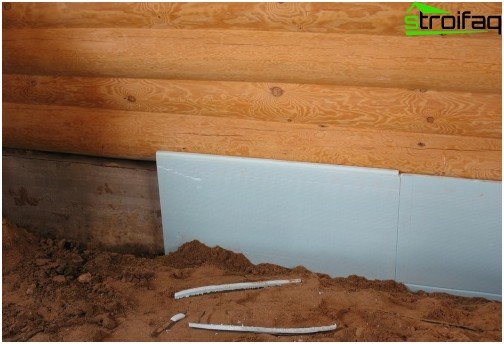
Insulation of the foundation with polystyrene from the inside of the house
Materials and methods of insulation of the foundation outside
In this case, foam, polystyrene foam and polyurethane foam can be used as heat-insulating materials. The latter is applied in the same way as when insulating the foundation from the inside, only before spraying the polyurethane foam, it will be necessary to carry out some preparatory work to expose the bottom of the base of the house.
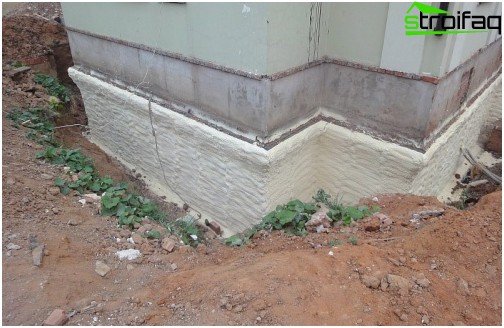
Insulation of the foundation outside the house with polyurethane foam
Operational method – polystyrene insulation
For insulation with polystyrene or polystyrene foam, it will be necessary to free the entire foundation from the ground. To do this, a trench is dug around the perimeter of the house to the depth of the foundation with a width of about 40-50 centimeters. Then the surface is carefully cleaned of the remnants of the earth and leveled (if this, of course, is necessary). Waterproofing is applied to clean, dry walls, and then insulation sheets are attached to a special adhesive or bitumen mastic. The joints between them are filled with foam (this technique will protect the foundation from moisture).
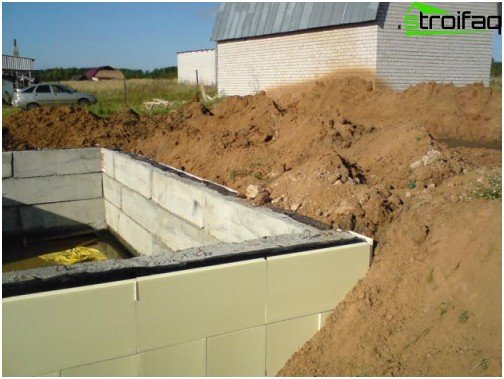
Insulation of the foundation with polystyrene foam outside the building
Important: the top sheets of the insulation should rise by about 40 cm at the ground level – this will protect both the foundation and walls from the possible rise of groundwater.
After all the work on gluing polystyrene or foam sheets is completed, you can begin to backfill the trench. A layer of sand (10 – 12 cm) is poured onto its bottom, then it is possible to put sheets of insulation (or you can not put it), after – a layer of gravel (60 – 70 cm), and then you can fill it with concrete, you can fill it with the same sand, and you can roll the asphalt. If you are a creative person and love everything original and unusual, then you can decorate everything with stone or tile.
Providing thermal insulation with expanded clay
Another way to warm the foundation from the outside is the use of expanded clay. True, this method is already partially going into oblivion, since it is quite costly and inefficient, although our parents used it to build houses.
The process of warming with expanded clay is in many respects similar to polystyrene warming. We dig a trench with a width of at least 1 meter to the entire depth of the foundation. Waterproofing material is laid at the bottom of the trench, and expanded clay granules are poured on top. The layer should be thick enough, because expanded clay has very weak thermal insulation properties. Ruberoid is laid on top of expanded clay and sand or earth is poured.
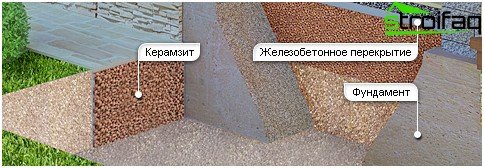
Exterior foundation insulation with expanded clay
If you decide to save on workers and conduct foundation insulation with your own hands, then you can use not only modern materials for these purposes, but also those that our ancestors used. True, there will be little use of straw, peat, leaves or needles, because if these affordable, natural “heaters” really helped in the fight against cold and frost, would a person begin to look for a replacement?
Warming the foundation, no matter what you are told, is necessary in any case, because the weather conditions in Russia are so unpredictable that even weather forecasters themselves are not able to answer the question of what awaits us tomorrow. Even if you live in Sochi or the Krasnodar Territory, where the temperature is usually stable at around zero, do not take risks, but take care of your home, otherwise it will be too late.


